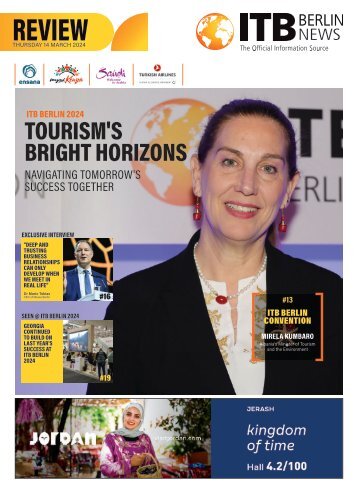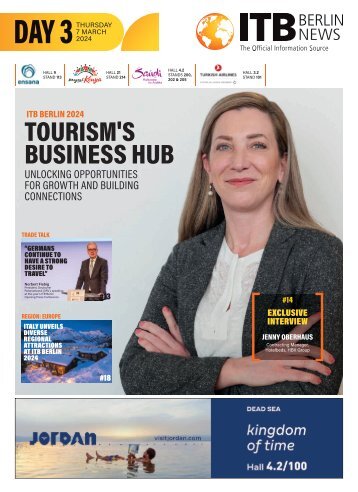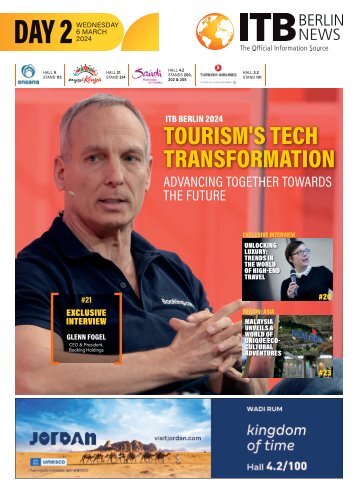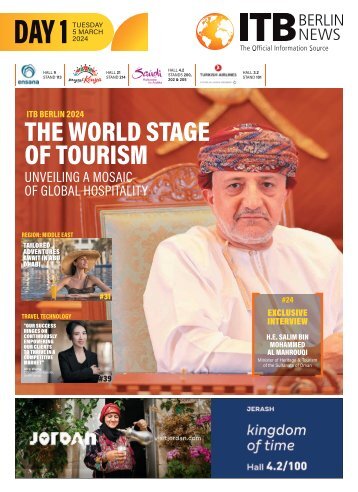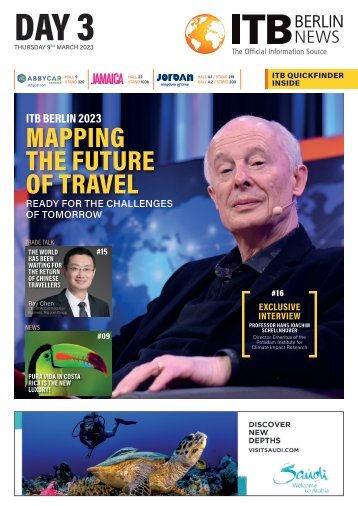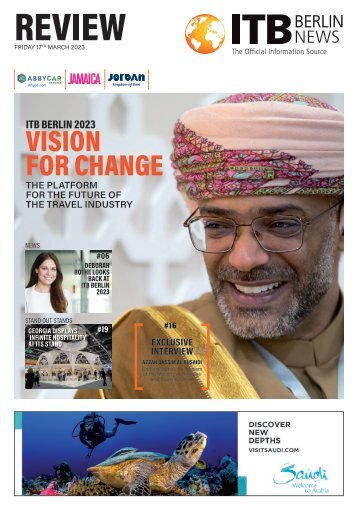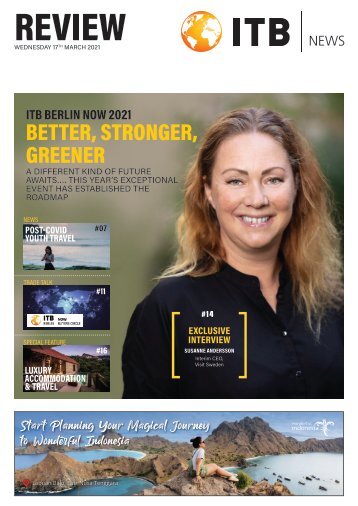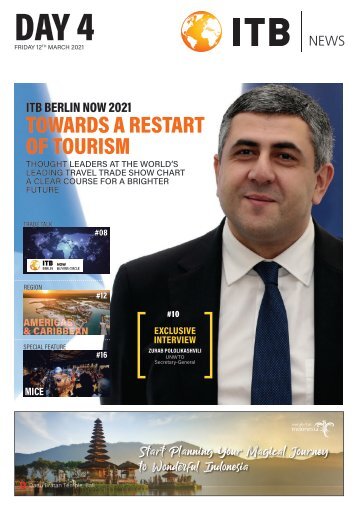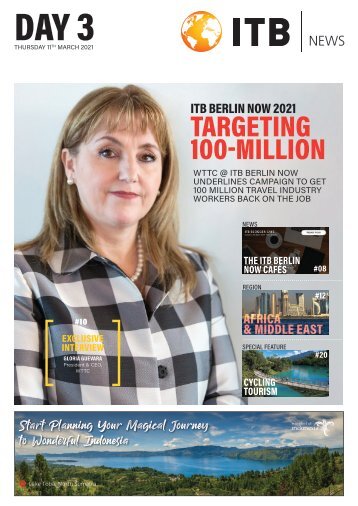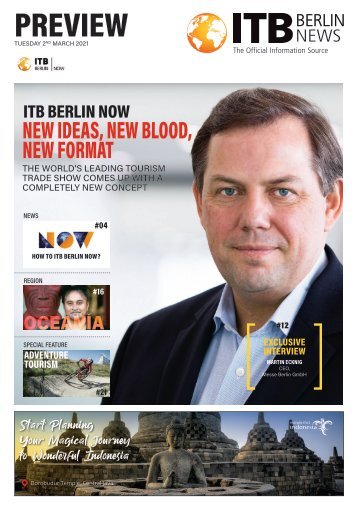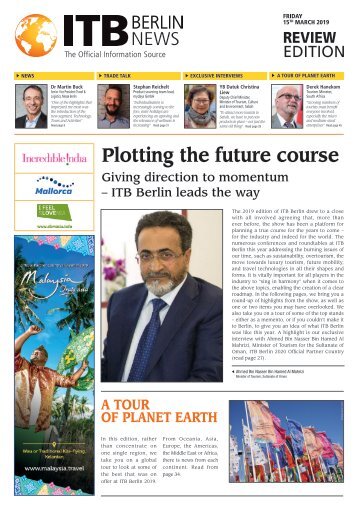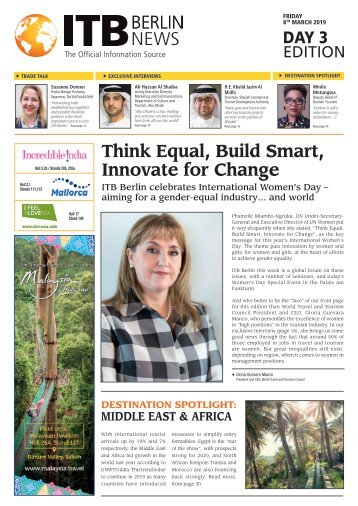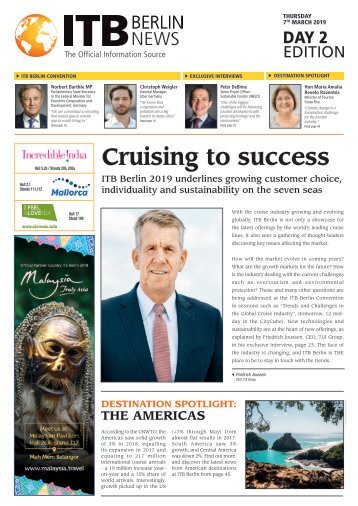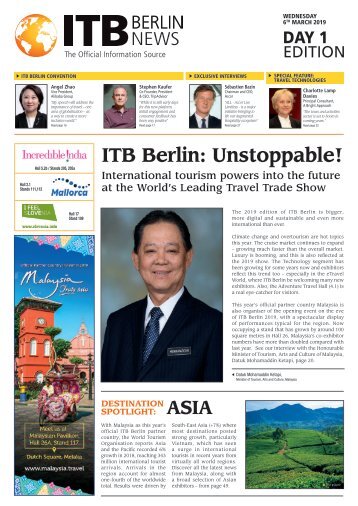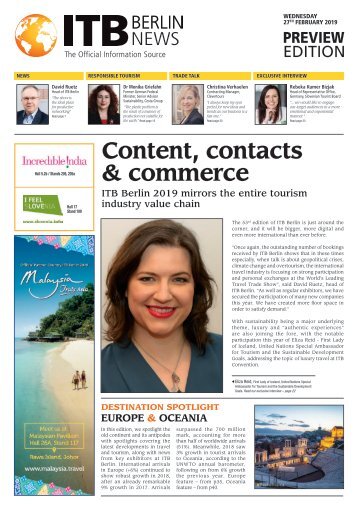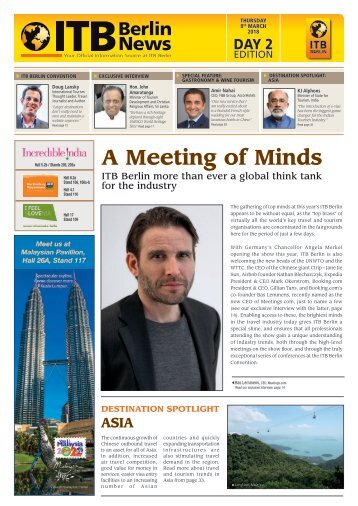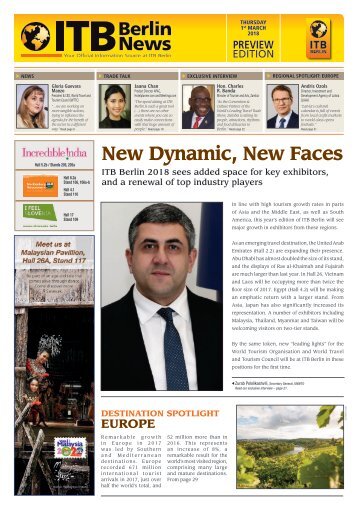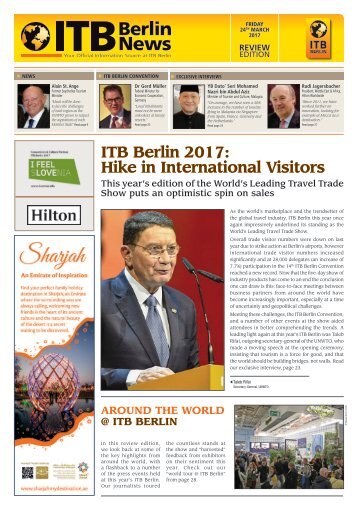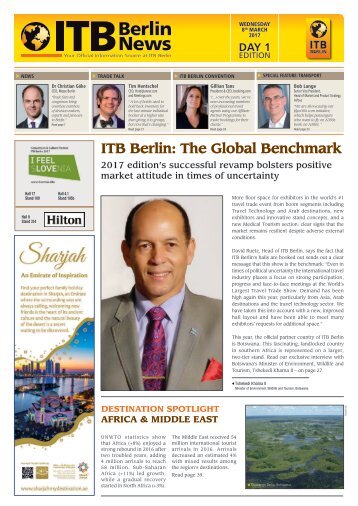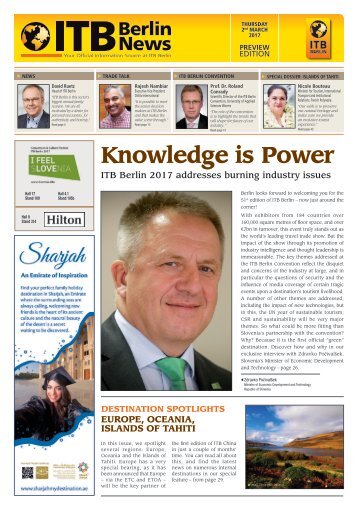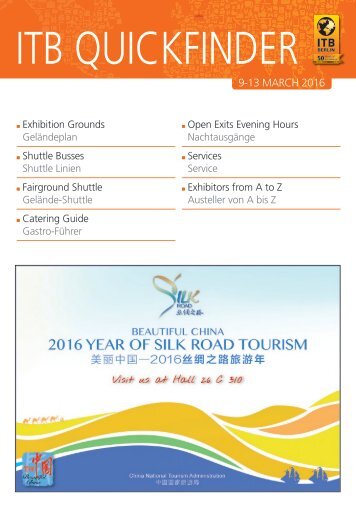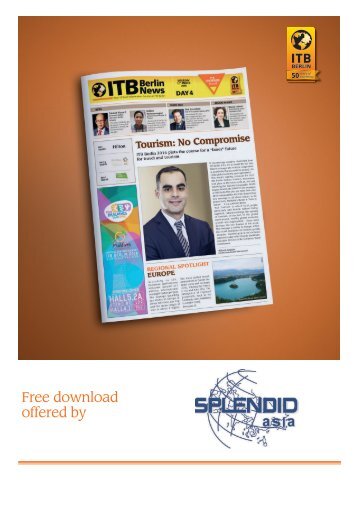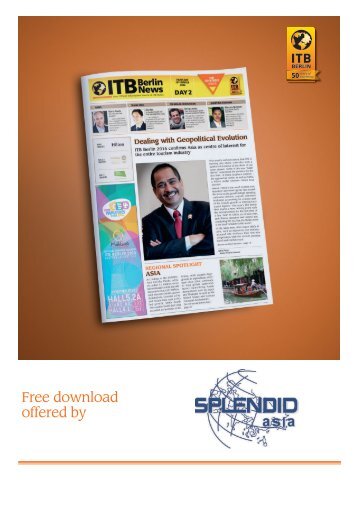
ITB Berlin News 2018 - Preview Edition
- Text
- Tourism
- Hotels
- Tours
- Resort
- Berlin
- Exhibitors
- Resorts
- Halle
- Tourismus
- Aussteller
- Www.cleverdis.com
38 REGION OCEANIA
38 REGION OCEANIA ISLANDS OF TAHITI SPECIAL DOSSIER The Islands of Tahiti – a Different Take New Positioning of French Polynesia as a Tourist Destination Recent studies by Hawaii Pacific University have showed that French Polynesia has a very strong image among tourists: a tropical paradise, preserved from the destruction of the modern world. White sandy beaches, warm and translucent waters, bungalows and beautiful sunsets characterise the destination, evoking rest, relaxation and well-being. The opportunities or “external” motivating factors for tourists, seen as being assets of the destination “French Polynesia”: White sand beaches Tropical water temperature Volcanic mountain peaks Flora and fauna of a huge variety of colours Richness of traditions and cultural heritage Intangible experiences connected with getting away from it all, rest, relaxation Multiple visits and excursions Recreation and Sport Entertainment A strong cultural identity and the quality of the Polynesian welcome are also important contributing factors in making French Polynesia an ideal holiday place. The Hawaii Pacific University study identifies the differences between preconceived ideas about the destination and what the destination can offer in terms of products and experiences. Identifying and bridging these gaps is essential to ensure the future development of tourism, as well as its sustainable economic and social contributions to French Polynesia. Significant elements motivating the choice of an ideal holiday destination come out when one asks tourists about French Polynesia: Tahaa Nuku Hiva Friendliness of the population, Cleanliness of local communities, Availability of leisure and cultural activities, Easy access to drinking water, A region in peace, without a climate of violence or terrorism, Low risk of natural disasters and the absence of major tropical diseases. Indeed, the destination benefits from a very positive image: an Eden-like place of dreams - wild and preserved. The high cost of © Audrey Svoboda - Tahiti Tourisme the destination is interpreted as an exclusivity, with very high-end services, a form of protection of the existing environment that evokes the prestige of having experienced the ultimate paradise. Given these perceptions, and in order to bring reality up to the level of the myth, the Government has revealed a plan towards the encouragement of: Restoring the image of Polynesian culture, in line with its myth, Choosing a more elitist, confidential, and non-mass model, Renovating and improving the quality of establishments and services, Integrating the population into economic development, Promoting ecotourism, Structuring products and making them more legible and accessible Ensuring the destination remains an oasis of peace. QUALITY AS A DIFFERENTIATOR With average stays at 12 days in 2015, the daily expenditure of a tourist in French Polynesia is much higher than all direct competitors, such as Mauritius, Hawaii, or Fiji. © Tahiti Tourisme For example, in 2015, Fiji received four times as many tourists, but tourism turnover was reported to be only 2.7 times that of French Polynesia. Thus, if French Polynesia was to double its number of tourists from 180,000 in 2015 to 360,000, it should reach a tourism turnover similar to that of Fiji. It is important to note that “cruise” tourists are very different from “terrestrial” tourists. Those on cruises spend a maximum of two days on the land in local hotels, and consume much less than those who are not on cruises, even if they stay for a number of days, as most of their meals are consumed on the ship, as part of “all inclusive” packages. THE ADVANTAGES OF BEING A REMOTE DESTINATION French Polynesia has been generally spared from the environmental impact observed among its main competitors, due primarily to its light population and tourist density. This has been a major comparative advantage given growing global concerns with regard to sustainability, especially among the kind of visitors considering the Islands of Tahiti as a destination. The isolation of these islands, long considered a handicap, is thus seen as a key asset, as it favours the preservation of the environment and the richness of the local biodiversity, allows for the preservation of cultural identity and values of Polynesian society, maintains the myth of adventure and rarity, avoids mass tourism, and also favours security from delinquency and terrorism Hall 5.2a/ Stand 105 ITB BERLIN NEWS • Thursday 1 st March 2018 www.itb-berlin-news.com
ISLANDS OF TAHITI SPECIAL DOSSIER OCEANIA REGION 39 © Audrey Svoboda - Tahiti Tourisme © Gregoire LE BACON - Tahiti Tourisme Raiatea Bora Bora A Quick Tour of the Isles 118 islands spread across 5 archipelagos With a maritime empire expanding over 5 million sq km (equivalent to the size of Europe), only 3,500 sq km is actual land. This land forms 5 different archipelagos: Society, Tuamotu, Gambier, Marquesas and the Australs. French Polynesia is also part of the Polynesian Triangle, which borders Easter Island, New Zealand and Hawaii. Located between California (6,195 km.) and Australia (4,989 km.), Tahiti is 8,803 km. from Tokyo and 7,500 km. from Santiago in Chile: a perfect location in the heart of the South Pacific. THE SOCIETY ISLANDS: A DREAM COME TRUE From the country’s main heartbeat island, Tahiti, across to her enchanting sister island, Moorea, then up to Marlon Brando’s Tetiaroa paradise atoll, these Windward Islands are the utmost of dream islands. The deep valleys and high mountains offer incredible hikes, or with a 4WD one can discover the legendary archaeological remains of ancient Polynesia. The Leeward Islands, or Carromata’s consist of five islands: Huahine, sought after for her mysterious charm; Raiatea or “The sacred island”; Taha’a, a genuine Garden of Eden surrounded with colours and scent; Bora Bora, “The pearl of the Pacific”; and Maupiti - the smallest and least developed of all, but nonetheless as beautiful. THE TUAMOTU ARCHIPELAGO: PARADISE ON EARTH The Tuamotu Islands consist of 77 atolls spread over 1,500 km. and the area certainly lives up to its reputation! They are the best representation of the “edge of the world” and quite literally paradise on earth. Coconut plantations cover the motu (islet) of the coral barrier reef, white sandy beaches, the pristine beauty of the lagoons and unique underwater world make the Tuamotu a very unique group of islands. THE GAMBIER ARCHIPELAGO: A WELL-KEPT TREASURE Located more than 1,600 km southeast of the island of Tahiti at the end of the Tuamotu’s, this archipelago is the most remote and also the least populated of French Polynesia, counting only 1,000 inhabitants. It shelters four mountainous islands lying within the same lagoon: Mangareva, ‘Akamaru, ‘Aukena and Taravai, with dozens of islets, called motu. This archipelago lives to the pace of Christian faith, pearl farms and fishing. Thus, visitors will discover the many secrets of these authentic and discreet islands, including one of the most beautiful lagoons in the region (featuring unbelievable shades of blue) and untouched and colourful marine life. THE AUSTRAL ARCHIPELAGO: INTIMATE POLYNESIA As their name implies, the Austral islands, located on the Tropic of Capricorn, are the southernmost boundary of the Polynesian archipelago. The climate is cooler than in Tahiti and the shape and ecology of these food self-sufficient islands make them a charming world apart. Rurutu, Tubuai or Tupua’i, Raivavae, Rimatara and the southernmost Rapa are high mountainous islands of real character. Rurutu, over the years, has become a great place to watch whales. Its crystal clear and calm waters allow the traveller to approach these sea giants in a privileged manner. THE MARQUESAS’ ARCHIPELAGO: THE FORCE OF CULTURE Legendary high cliffs, volcanic peaks, impressive remnants wrapped in wild nature, amazing beaches: the Marquesas are breathtaking! 1,500 km. away from Papeete, they offer the traveller an appealing, unforgettable and unmatched program. “The land of Man”, or “Te Fenua ‘Enata”, as the Marquesans name their islands, has various faces, all shaped by its inhabitants. Each of the six populated islands are proud of its characteristics and boasts highquality traditional and creative handicrafts, tattoos, singing and dancing – such as the rhythmic and impressive haka Hall 5.2a/ Stand 105 ITB BERLIN NEWS • Thursday 1 st March 2018
- Page 1: THURSDAY 1 st MARCH 2018 PREVIEW ED
- Page 5: NEWS 5 David Ruetz Head of ITB Berl
- Page 8 and 9: ITB BERLIN NEWS • Thursday 1 st M
- Page 10 and 11: 10 NEWS Skysuite at Aria Las Vegas
- Page 12 and 13: 12 NEWS ITB Business Travel Forum:
- Page 14 and 15: 14 NEWS ADVERTORIAL Opening New Rou
- Page 16 and 17: 16 ITB BERLIN CONVENTION Dr. David
- Page 19 and 20: 19 ITB Buyers Circle Big business i
- Page 21 and 22: EXCLUSIVE INTERVIEW 21 Zurab Pololi
- Page 23 and 24: SPECIAL FEATURE ADVENTURE TRAVEL 23
- Page 25 and 26: SPECIAL FEATURE YOUTH TRAVEL 25 YOU
- Page 27 and 28: EUROPE REGION 27 © D Bosnic Danube
- Page 29 and 30: EUROPE REGION 29 Chinese Tourists L
- Page 31 and 32: EUROPE REGION 31 BALTICS CENTENARY
- Page 33 and 34: OCEANIA REGION 33 © Khufu Osiris M
- Page 35: OCEANIA REGION 35 Stone the Crows,
- Page 41 and 42: © Thomas Keller HOSPITALITY / REST
- Page 45 and 46: ITB QUICKFINDER 7-11 MARCH 2018 Exh
- Page 47 and 48: Hall 1.1 / Stand 203 Hall 20 / Stan
- Page 49 and 50: CATERING GUIDE GASTRO-FÜHRER CATER
- Page 51 and 52: EXHIBITORS FROM A TO Z / AUSTELLER
- Page 53 and 54: A / B EXHIBITORS / AUSSTELLER HALL
- Page 55 and 56: B / C EXHIBITORS / AUSSTELLER HALL
- Page 57 and 58: C / D / E EXHIBITORS / AUSSTELLER H
- Page 59 and 60: E / F / G / H EXHIBITORS / AUSSTELL
- Page 61 and 62: H / I / J EXHIBITORS / AUSSTELLER H
- Page 63 and 64: J / K / L / M EXHIBITORS / AUSSTELL
- Page 65 and 66: M / N EXHIBITORS / AUSSTELLER HALL
- Page 67 and 68: N / O / P / Q / R EXHIBITORS / AUSS
- Page 69 and 70: R / S EXHIBITORS / AUSSTELLER HALL
- Page 71 and 72: S / T EXHIBITORS / AUSSTELLER HALL
- Page 73 and 74: T EXHIBITORS / AUSSTELLER HALL / HA
- Page 75 and 76: T / U / V / W EXHIBITORS / AUSSTELL
Inappropriate
Loading...
Mail this publication
Loading...
Embed
Loading...
